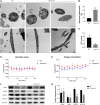TMPRSS12 Functions in Meiosis and Spermiogenesis and Is Required for Male Fertility in Mice
- PMID: 35547804
- PMCID: PMC9081376
- DOI: 10.3389/fcell.2022.757042
TMPRSS12 Functions in Meiosis and Spermiogenesis and Is Required for Male Fertility in Mice
Abstract
Serine proteases are involved in many physiological activities as initiators of proteolytic cascades, and some members have been reported to play roles in male reproduction. Transmembrane serine protease 12 (TMPRSS12) has been shown to regulate sperm motility and uterotubal junction migration in mice, but its role in the testis remains unknown. In this study, we verified that TMPRSS12 was expressed in the spermatocytes and spermatids of testis and the acrosome of sperm. Mice deficient in Tmprss12 exhibited male sterility. In meiosis, TMPRSS12 was demonstrated to regulate synapsis and double-strand break repair; spermatocytes of Tmprss12 -/- mice underwent impaired meiosis and subsequent apoptosis, resulting in reduced sperm counts. During spermiogenesis, TMPRSS12 was found to function in the development of mitochondria; abnormal mitochondrial structure in Tmprss12 -/- sperm led to reduced availability of ATP, impacting sperm motility. The differential protein expression profiles of testes in Tmprss12 -/- and wild-type mice and further molecule identification revealed potential targets of TMPRSS12 related to meiosis and mitochondrial function. Besides, TMPRSS12 was also found to be involved in a series of sperm functions, including capacitation, acrosome reaction and sperm-egg interaction. These data imply that TMPRSS12 plays a role in multiple aspects of male reproduction.
Keywords: TMPRSS12; male infertility; meiosis; serine protease; spermiogenesis.
Copyright © 2022 Zhang, Zhou, Wan, Yu, Chen, Yan, Wu, Zheng, Zhu and Zhu.
Conflict of interest statement
The authors declare that the research was conducted in the absence of any commercial or financial relationships that could be construed as a potential conflict of interest.
Figures








Similar articles
-
Tmprss12 is required for sperm motility and uterotubal junction migration in mice†.Biol Reprod. 2020 Aug 4;103(2):254-263. doi: 10.1093/biolre/ioaa060. Biol Reprod. 2020. PMID: 32529245 Free PMC article.
-
PRSS55 plays an important role in the structural differentiation and energy metabolism of sperm and is required for male fertility in mice.J Cell Mol Med. 2021 Feb;25(4):2040-2051. doi: 10.1111/jcmm.16116. Epub 2021 Jan 8. J Cell Mol Med. 2021. PMID: 33417308 Free PMC article.
-
Testis-expressed protein 33 is not essential for spermiogenesis and fertility in mice.Mol Med Rep. 2021 May;23(5):317. doi: 10.3892/mmr.2021.11956. Epub 2021 Mar 24. Mol Med Rep. 2021. PMID: 33760102 Free PMC article.
-
Autophagy: a multifaceted player in the fate of sperm.Hum Reprod Update. 2022 Feb 28;28(2):200-231. doi: 10.1093/humupd/dmab043. Hum Reprod Update. 2022. PMID: 34967891 Free PMC article. Review.
-
Haploid male germ cells-the Grand Central Station of protein transport.Hum Reprod Update. 2020 Jun 18;26(4):474-500. doi: 10.1093/humupd/dmaa004. Hum Reprod Update. 2020. PMID: 32318721 Review.
Cited by
-
Large-scale CRISPR/Cas9 deletions within the WFDC gene cluster uncover gene functionality and critical roles in mammalian reproduction.Proc Natl Acad Sci U S A. 2024 Dec 17;121(51):e2413195121. doi: 10.1073/pnas.2413195121. Epub 2024 Dec 12. Proc Natl Acad Sci U S A. 2024. PMID: 39665756 Free PMC article.
-
Protein disulfide isomerase is essential for spermatogenesis in mice.JCI Insight. 2024 Jun 24;9(12):e177743. doi: 10.1172/jci.insight.177743. JCI Insight. 2024. PMID: 38912589 Free PMC article.
-
Sex differences in gene expression and alternative splicing in the Chinese horseshoe bat.PeerJ. 2023 Apr 24;11:e15231. doi: 10.7717/peerj.15231. eCollection 2023. PeerJ. 2023. PMID: 37123006 Free PMC article.
-
Rescue of male infertility by human PRSS55 in transgenic mice establishes a contraceptive research model.Sci Rep. 2025 Aug 5;15(1):28657. doi: 10.1038/s41598-025-09604-9. Sci Rep. 2025. PMID: 40764777 Free PMC article.
References
-
- Akhmanova A., Mausset-Bonnefont A.-L., van Cappellen W., Keijzer N., Hoogenraad C. C., Stepanova T. (2005). The Microtubule Plus-End-Tracking Protein CLIP-170 Associates with the Spermatid Manchette and Is Essential for Spermatogenesis. Genes Dev. 19, 2501–2515. 10.1101/gad.344505 - DOI - PMC - PubMed
-
- Barrett A. J. (2004). Bioinformatics of Proteases in the MEROPS Database. Curr. Opin. Drug Discov. Devel 7, 334–341. - PubMed
LinkOut - more resources
Full Text Sources
Molecular Biology Databases

